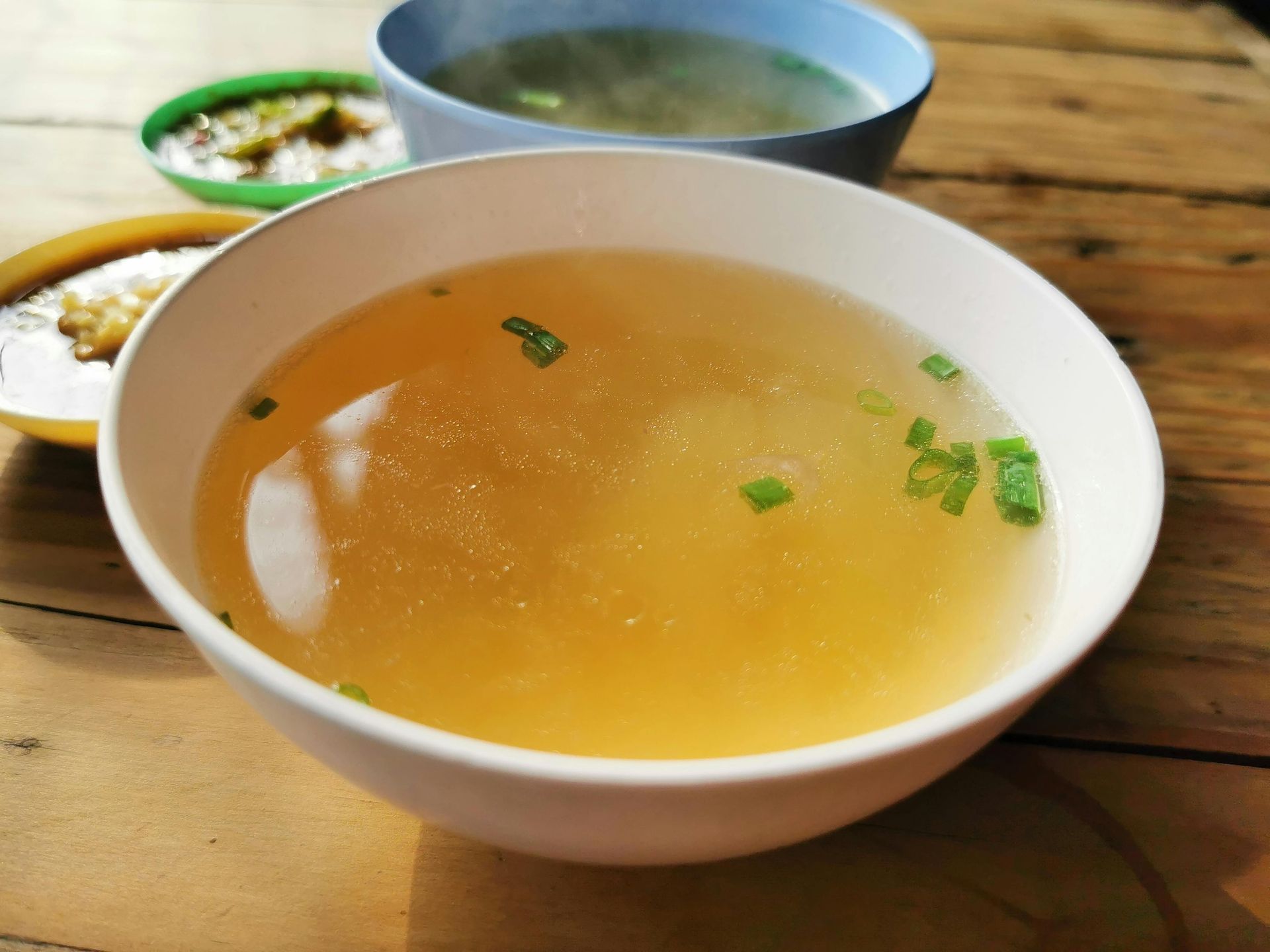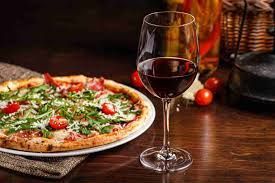Unveiling Coombsville: Napa’s Most Underrated AVA
jim • December 27, 2024
Unveiling Coombsville: Napa’s Most Underrated AVA
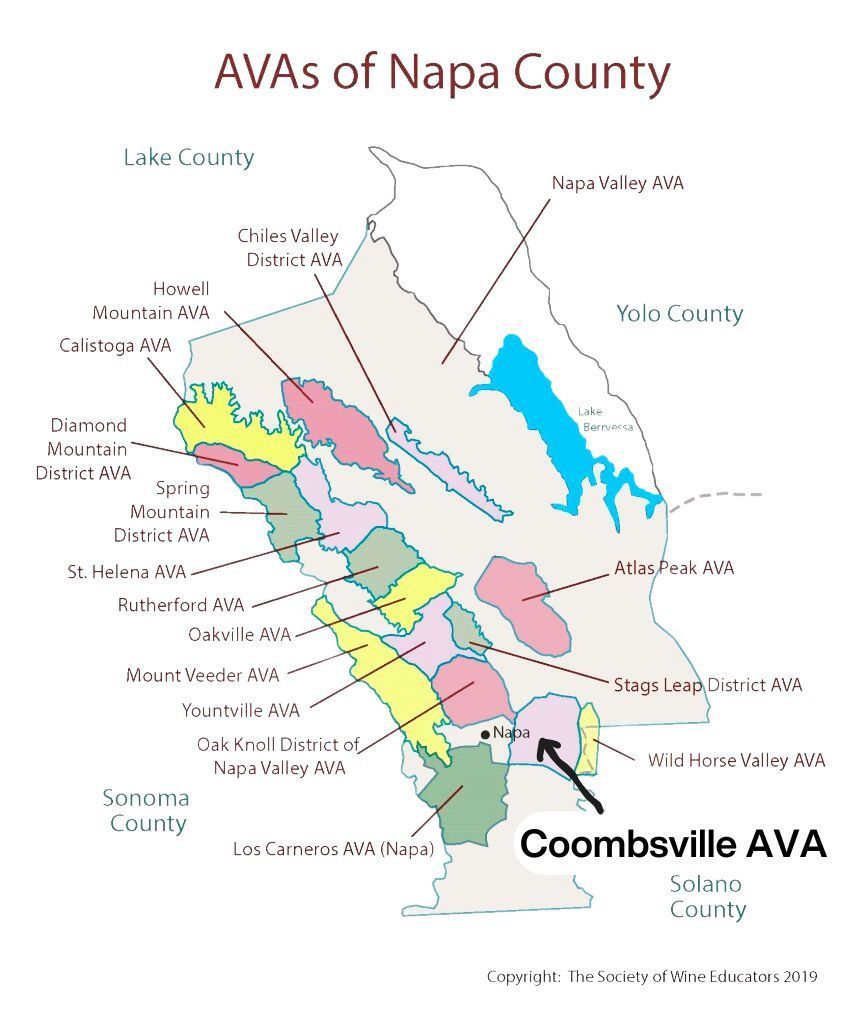
Hidden in the southeastern corner of Napa Valley, Coombsville is an AVA (American Viticultural Area) that often flies under the radar. While much of Napa is synonymous with opulent tasting rooms and bustling crowds, Coombsville offers a refreshing contrast—tranquil multi-generational family farms with a character all its own. Its volcanic soils, cooler climate, and artisanal approach to winemaking produce wines that are as refined as they are distinctive. Before becoming an AVA, Coombsville was the secret in many winemakers’ cabernet sauvignon, blending it in to provide a rounder fruity character to offset the intense tannic structure of many northern Napa wines.
Coombsville is the Napa of yesteryear, often nostalgically portrayed in movies and history books. Where a farm is family-owned, the vineyards have tools lying around, and you will often meet the person who is the winemaker and vineyard owner when you visit. It is a significant contrast to the rest of Napa, which has more of a commercial feel.
This article will explore what makes Coombsville one of Napa Valley’s best-kept secrets. From its unique terroir to its exceptional wineries, we’ll uncover why this quiet gem deserves a place on every wine lover’s radar.
Where Is Coombsville, and Why Is It Special?
Coombsville is just a few miles east of downtown Napa, but it feels worlds apart. Officially recognized as an AVA in 2011, this region covers approximately 11,000 acres of rolling hills, scenic vineyards, and quiet backroads. Despite being one of the youngest AVAs in Napa Valley, Coombsville has quickly gained a reputation for its high-quality wines and serene atmosphere.
It sits inside an ancient caldera where, eons ago, a volcano collapsed on itself. Subsequently, water filled the space where the volcano used to be and was filled with aquatic life. Then, the landscape replaced the water bed that gives us the Coombsville we see today. The evidence of its past can still be found, and it is not uncommon to find imprints of life forms on the diatomaceous earth that can be found throughout the region.
From a vineyard’s perspective, being so close to the San Pablo Bay gives Coombsville a growing advantage because the fog rolls in early in the day and out later than any of the northern AVAs. This results in a relatively longer growing season that the other Napa AVAs. A longer growing season results in rounder, complex, fruit-forward Cabernet Sauvignons.
In addition to its geological past, Coombsville's uniqueness is its understated charm. Unlike the bustling wineries of Oakville or St. Helena, Coombsville is a place where visitors can enjoy intimate tasting experiences and often meet the winemakers themselves. Its cooler climate, influenced by breezes from the San Pablo Bay, provides ideal conditions for crafting wines with elegance and balance.
The Unique Terroir of Coombsville
One of Coombsville’s defining features is its exceptional terroir, which shapes the character of its wines. Unlike the warmer regions of Napa Valley, Coombsville enjoys a cooler climate thanks to its proximity to the San Pablo Bay. The gentle breezes and morning fog create a longer growing season, allowing grapes to ripen slowly and develop more complex flavors.
Beneath the surface, Coombsville’s volcanic soils tell a story millions of years in the making. The region’s rocky terrain is rich in volcanic ash, pumice, and gravel, remnants of ancient geological activity. This soil composition ensures excellent drainage—vital for healthy vines—and imparts a distinct minerality to the wines, a hallmark of Coombsville’s style.
The interplay of cool temperatures and volcanic soils results in elegant and balanced wines, with bright acidity and layered depth. Red varietals, particularly Cabernet Sauvignon, exhibit refined tannins, dark fruit notes, and hints of earthiness. White wines, though less common, often display crisp acidity and a mineral-driven profile.
This unique combination of climate and soil makes Coombsville ideal for winemakers seeking to craft wines that reflect a true sense of place and time. A quality harvested vineyard will express the terroir and the season (i.e., vintage). This gives the winemaker a palette from which to work to make distinctive wines that are characteristic of the vintage and spirit of Coombsville.
Wines of Coombsville: What to Expect
Coombsville may be one of Napa Valley’s quieter AVAs, but its wines speak volumes. Known primarily for its exceptional Cabernet Sauvignon, the region produces wines that are distinctively elegant and structured. The cooler climate and volcanic soils contribute to a flavor profile that sets Coombsville apart from the bolder, more opulent wines of Napa’s warmer AVAs.
Cabernet Sauvignon: The Star of Coombsville
Coombsville Cabernet Sauvignon is celebrated for its refined tannins, dark fruit flavors, and hints of earth and graphite. These wines often feature notes of blackcurrant, plum, and cherry, complemented by subtle herbal undertones and a touch of minerality. Thanks to the cooler growing conditions, Coombsville Cabernets tend to be more balanced and age-worthy, making them a favorite among collectors and connoisseurs.
Other Notable Varietals
While Cabernet dominates, Coombsville is also home to other standout varietals:
- Cabernet Franc: fresh red fruits, herbs, spice, and sometimes tobacco. Exciting news is to come on this special varietal!
- Merlot: Plush, velvety wines with ripe red berry and cocoa flavors.
- Syrah: Bold, with notes of blackberry, pepper, and smoked meat.
- Chardonnay: Crisp and mineral-driven, with bright citrus flavors and hints of green apple.
- And there is more to come!
What Sets Coombsville Wines Apart?
The hallmark of Coombsville wines lies in their balance and complexity. The cooler climate and longer growing season preserves natural acidity, giving the wines freshness and vibrancy, while the volcanic soils add depth and structure. These characteristics make Coombsville wines food-friendly and versatile, pairing beautifully with a wide range of dishes, from grilled meats to hearty vegetarian fare.
Whether you’re a seasoned collector or a casual wine enthusiast, Coombsville’s wines offer a unique perspective on Napa Valley’s diverse winemaking landscape. While the wines are typically approachable on release, they age wonderfully. I recommend getting a couple of bottles of the same vintage to drink on release, five years later, and then 10 years to appreciate how they evolve over time.
Must-Visit Wineries in Coombsville
Coombsville’s charm lies not only in its exceptional wines but also in the intimate, welcoming experiences offered by its wineries. Unlike the grand estates of Napa’s more famous regions, Coombsville is home to smaller, boutique operations where visitors can enjoy personalized tastings and a deeper connection with the winemaking process.
The wines that follow are some of the more well-known producers, but I have to stress that there are many small production wineries that should be sought out, such as Terra Solis, Farang Wine, Shady Brook, Lunar Ridge, Marita’s Vineyard, Sodaro Estate Winery, Tournesol
Wine, Sciandri Family Vineyards, and many more. Many require advance notice before visiting them, so be sure to coordinate with them ahead of your visit.
- Caldwell Vineyard: A trailblazer in Coombsville, Caldwell Vineyard is known for its innovation and exceptional Bordeaux-style wines. Guests can tour the impressive cave system and enjoy a private tasting experience featuring limited-production wines like their sought-after Cabernet Sauvignon and Sauvignon Blanc.
- Farella Vineyard: Farella is a family-owned winery producing wines that beautifully express Coombsville’s terroir. Their estate Cabernet Sauvignon is a standout, showcasing elegance and balance. The intimate tasting room provides an excellent opportunity to learn about the vineyard’s sustainable farming practices.
- Covert Estate: This modern yet understated winery offers a luxurious tasting experience in a tranquil setting. Covert Estate specializes in small-lot wines, including exceptional Merlot and Cabernet Franc. The sleek, subterranean tasting room adds an element of exclusivity to the visit.
- Porter Family Vineyards: Nestled in the rolling hills of Coombsville, Porter Family Vineyards is known for its small-batch wines and stunning views. Their estate-grown Syrah and Cabernet Sauvignon are must-tries, and the vineyard’s commitment to sustainability is a bonus.
- Black Cat Vineyard: For those seeking a truly boutique experience, Black Cat Vineyard is a hidden gem. This tiny, family-run operation offers handcrafted wines and tastings that feel like a visit to a friend’s home.
A Tranquil Escape from Napa’s Crowds
For those who have experienced the bustling crowds and commercialized vibe of Napa Valley’s more famous regions, Coombsville offers a refreshing alternative. This AVA is a haven for wine lovers seeking serenity, authenticity, and a more intimate connection to the land and winemakers. You will not find a lot of signs or traffic in the area. You will see neighbors sitting on porches, vineyard owners walking their fields, and a lot of pickup trucks.
A Slower Pace of Life
In Coombsville, time seems to slow down and preserve the spirit of the 1960s era Napa. The region’s rolling hills, dotted with vineyards and oak trees, provide a picturesque backdrop that invites visitors to linger and savor the moment. Unlike the high-energy tasting rooms of St. Helena or Yountville, Coombsville’s wineries offer a relaxed, unhurried atmosphere where you can truly appreciate the wines and the stories behind them. There is time for humble conversation and connection between visitors and farmers/winemakers.
Intimate Tasting Experiences
Many of Coombsville’s wineries are family-owned and emphasize personal connections with guests. Tastings often feel like a conversation with the winemaker or vineyard owner rather than a scripted tour. This personal touch deepens your understanding of the craftsmanship behind each bottle but does not alienate anyone from thinking about whether they could do it as well. Visitors will get a true sense of the work ethic and the love of winemaking.
Off-the-Beaten-Path Adventures
The charm of Coombsville lies in its relative obscurity. Visitors can explore winding country roads and discover hidden gems without the crowds that typically accompany Napa Valley’s hotspots. Whether it’s a private cave tasting or a stroll through a family-owned vineyard, Coombsville offers the kind of intimate adventures that are increasingly rare in wine country.
A Place to Unwind
Beyond the wine, Coombsville’s tranquil setting makes it an ideal escape for those looking to recharge. The peaceful landscapes, mild weather, and genuine hospitality create an atmosphere that’s as rejuvenating as it is enriching. It’s a reminder that sometimes, the best wine country experiences aren’t about the most prominent names or the flashiest venues—they’re about the quiet, personal moments that make you fall in love with the journey.
Insider Tips for Visiting Coombsville
A visit to Coombsville is all about embracing the charm of Napa Valley’s quieter side. To make the most of your trip, here are some insider tips to ensure an unforgettable experience:
Plan Ahead
- A great free personalized service is Coombsville Concierge Service . Seriously, at no cost you can reach out to them, they will listen to what you want to get our of your trip to Napa, and give you a personalized itinerary and insight that takes the entire valley into mind.
- Appointment-Only Wineries: Most well-known wineries (the six mentioned above) in Coombsville require reservations. Plan your itinerary early to secure tastings at your top choices. Smaller wineries can be more casual in their planning so never hesitate to give them a call. Often, the owner will pick up the phone, and the conversation will be more about arranging schedules than evaluating you in a line of other visitors.
- Private Tastings: Many wineries offer private or small-group experiences, so be sure to inquire about these for a more personalized visit.
Best Times to Visit
- Harvest Season (September–October): Witness harvest excitement while enjoying the vineyards' vibrant colors. Note that this is an exciting time but also extremely busy. You will see a lot of action.
- Spring (March-May): Lush green landscapes and fewer crowds make this a peaceful time to explore the area. This is a quieter time for wineries. Where they are evaluating the growth of their vineyards and starting to create a strategy for the harvest season. Many wineries also have other gardens in bloom, and it is an excellent opportunity to get fresh tomatoes, lemons, eggplant, and whatever else may be growing near the vineyard.
Getting Around
- Hire a Driver: To fully enjoy tastings without worrying about driving, consider hiring a car service or joining a private wine tour specializing in Coombsville.
- Explore by Bike: For the adventurous, the quiet roads of Coombsville make for scenic cycling routes. Drivers in the region are typically courteous, and the roads are wide and rolling. Many roads are shaded as well by beautiful oak trees.
Where to Stay
- Boutique Inns: Look for small, family-run inns or bed-and-breakfasts in nearby Napa or along the Silverado Trail for a cozy stay.
- Vacation Rentals: For a more immersive experience, consider renting a private home or vineyard cottage in the area.
Dining Recommendations
- Local Favorites: Pair your Coombsville wines with a meal at one of Napa’s farm-to-table restaurants. Popular spots like Scala and Oxbow Public Market are just a short drive away.
- Picnic at a Winery: Some wineries allow guests to enjoy a picnic on their grounds. Bring your favorite snacks and soak in the views with a glass of wine.
- Some of my personal casual favorites, not often on the radar, include:
- Croccante Pizza: Detroit-style pizza that will blow you away.
- Las Palmas: Amazing Mexican, where many local vineyard workers eat. The staff is super friendly.
- Mother’s Tacos: Fast food environment but amazing elevated tacos. A little expensive.
- Mustards: The best pork chop on earth and legendary Napa restaurant. It is outside of Napa but I love to mention this one. Expensive.
- Small World Restaurant: Casual Mediterranean. My go-to. Best Baklava (when then choose to make it)
- Napa Valley Coffee Roasting Company. On Friday mornings, they serve great bagels with artisan spreads. It's a great place to start an early day
Pack Smart
- Layered Clothing: Coombsville’s proximity to the San Pablo Bay means cooler mornings and evenings, so bring layers.
- Comfortable Shoes: If you’re exploring vineyards or caves, you’ll want footwear that can handle uneven terrain.
Wine Shipping Options
Many Coombsville wineries offer shipping services, so don’t hesitate to stock up on your favorite bottles. It’s the perfect way to relive your visit at home—or share the experience with friends. A great trick is to buy shipping boxes from Cartons & Crates. I have mailed and checked in at an airport as luggage many times without ever having an incident. This allows you to combine the wine you purchase at several wineries and combine them into one shipment, materially reducing your tax paid and shipping costs.
Why Coombsville Deserves More Attention
If you want to travel back in time to a place where Napa was not commercialized, farmers were approachable, and winemakers were willing to spend time with you to discuss why the wine is so important to them, Coombsville is for you. Wear casual clothes so that you can comfortably walk the vineyards and fit in with the locals.
Nestled in the southeastern corner of the region, this AVA embodies a slower, more personal approach to winemaking, where multi-generational family farms and approachable winemakers create a sense of connection rarely found in the commercialized bustle of northern Napa.
Its unique terroir—a combination of volcanic soils and a cooler climate influenced by the San Pablo Bay—produces wines that are as elegant as they are distinctive, with complex flavors and refined balance. This hidden gem offers intimate tasting experiences, often hosted by the winemakers themselves, along with a serene landscape of rolling hills and shaded country roads.
For wine enthusiasts seeking authenticity, a deeper connection to the land, and a glimpse of Napa's past, Coombsville is an unparalleled destination that deserves to be discovered.
Final Thoughts
Coombsville is a hidden gem waiting to be uncovered, offering a glimpse into the Napa Valley of yesteryear. With its serene landscapes, approachable winemakers, and exceptional wines shaped by unique volcanic soils and a cool climate, Coombsville stands apart from the hustle and bustle of its more commercialized neighbors. Whether you’re drawn by the allure of its refined Cabernet Sauvignons or the intimate, unhurried tasting experiences, this AVA invites you to slow down and savor every moment.
Plan your visit or seek out wines from Coombsville to experience the authenticity and charm that make this region so special. Experience Coombsville for yourself and uncover Napa Valley’s best-kept secret.

Our wine sells at a couple of fine wine establishments where it is common for customers to come in to grab a bottle on their way to a restaurant. With this in mind, I thought you might be interested in reading about the ground rules on what is commonly expected when people bring their wine to a restaurant. It can be frustrating paying top dollar at a restaurant that does not offer a wine that appeals to you. The solution is to bring your own bottle of wine. Bringing your own bottle of wine to a restaurant, often referred to as BYOB (Bring Your Own Bottle), can elevate your dining experience while showcasing your personal taste. However, navigating the etiquette of bringing wine to a restaurant requires finesse to ensure a smooth and respectful interaction with the establishment and its staff. This comprehensive guide covers the dos and don’ts of BYOB etiquette, optimized for search engines to help you master this sophisticated dining practice. Bringing your own wine allows you to enjoy a specific bottle that may not be on the restaurant’s wine list, celebrate a special occasion, or save on the cost of marked-up wine menus. However, proper etiquette ensures that your BYOB experience is enjoyable for everyone involved, including the restaurant staff and other diners. Check the Restaurant’s BYOB Policy in Advance Most restaurants are happy to accommodate you if you want to bring your own wine as long as you follow their policies. Before bringing a bottle of wine, confirm whether the restaurant allows BYOB and what their corkage fees are. Corkage fees are explained below, but are simply the fee charged for serving the bottle you bring. A couple of points to note: Call Ahead: Contact the restaurant to inquire about their BYOB policy. Ask about corkage fees, which typically range from $10 to $50, and whether there are restrictions on the type or number of bottles allowed. Check Online: Visit the restaurant’s website or social media pages for BYOB information. Some restaurants may list their corkage policy or specify if BYOB is limited to certain days or times. Respect Restrictions: Some restaurants only allow BYOB if the wine isn’t on their wine list. Avoid bringing a bottle that competes with their offerings to show respect for their business. Pro Tip: Use phrases like “Can I bring my own wine?” or “What is your corkage fee?” when inquiring to ensure clarity. Choose an Appropriate Wine Selecting the right bottle is a key part of BYOB etiquette. Consider the following when choosing your wine: Match the Cuisine: Pick a wine that complements the restaurant’s menu. For example, a crisp Sauvignon Blanc pairs well with seafood, while a robust Cabernet Sauvignon suits red meat dishes. Avoid Cheap Bottles: Bringing an inexpensive bottle may come across as disrespectful, especially if the restaurant has a curated wine list. Opt for a quality bottle that reflects thoughtfulness. Special Occasions: If you’re celebrating, consider bringing a unique or vintage bottle to enhance the experience, but ensure it’s appropriate for the setting. Understand and Respect the Corkage Fee A corkage fee is a charge imposed by the restaurant for opening and serving your wine. This fee covers the use of glassware, service, and the restaurant’s overhead. Here’s how to handle it gracefully: Ask About the Fee: Confirm the corkage fee when making your reservation. Be prepared to pay it without complaint, as it’s a standard practice. Tip Generously: Since the corkage fee doesn’t directly compensate the waitstaff, tip generously (typically 20% or more of the bill) to acknowledge their service in handling your wine. Remember, the tip is significantly reduced when you bring your own bottle, so in the spirit of good karma, I highly recommend overtipping. Don’t Haggle: Attempting to negotiate the corkage fee can create an awkward situation. Accept it as part of the BYOB experience. Extra Credit: If you want to take things to the next level, you can bring your own stemware. This is less common, but definitely a head turner. Present the Bottle Properly How you present your wine to the restaurant staff sets the tone for the experience. Follow these etiquette tips: Bring the Bottle Ready to Serve: Ensure the bottle is clean and at the appropriate temperature (chilled for whites, room temperature for reds). Avoid bringing a bottle that requires decanting unless you’ve confirmed the restaurant can accommodate it. Hand It Over Politely: Present the bottle to your server upon arrival, ideally when you’re seated. A simple, “We brought a bottle of wine—here it is,” suffices. Don’t Expect Special Treatment: The staff may be busy, so don’t demand immediate attention for your bottle. Allow them to open and serve it at their pace. Offer to Share with the Staff A thoughtful gesture that can enhance your dining experience is offering the sommelier, server, or chef a taste of your wine. This isn’t mandatory but can build goodwill, especially if you’ve brought a rare or high-quality bottle. Here’s how to do it: Make the Offer Discreetly: Say something like, “Would you or the sommelier like to try a glass of this wine?” This shows appreciation for their expertise. Don’t Pressure: If they decline (which they may due to restaurant policy or personal preference), accept it graciously Be Mindful of Other Diners Bringing your own wine should not disrupt the dining experience for others. Keep these points in mind: Keep It Subtle: Avoid flaunting your bottle or drawing attention to it. The focus should remain on the dining experience, not your wine. Don’t Overpour: Be mindful of pouring sizes to avoid excessive consumption that could lead to loud or disruptive behavior. Respect the Ambiance: Maintain the restaurant’s atmosphere by keeping conversations about your wine low-key and considerate. Handle Leftovers Gracefully If you don’t finish your bottle, be aware of the restaurant’s policy on taking leftovers home, as some regions have strict alcohol laws: Ask About Takeaway Rules: Inquire whether you can take the unfinished bottle with you. Some restaurants may reseal it or provide a to-go bag, while others may not allow it due to local regulations. A class move is always to leave any leftovers behind for the staff. Don’t Insist: If the restaurant cannot allow you to take the bottle, accept their policy without argument. Plan to consume what you bring to avoid waste. Follow General Dining Etiquette BYOB doesn’t exempt you from standard dining etiquette. To ensure a positive experience: Be Respectful: Treat the staff with courtesy and appreciation, acknowledging their effort in accommodating your wine. Plan Ahead: Make reservations and mention your intent to bring wine to avoid surprises for the restaurant. Stay Within Limits: Some restaurants cap the number of bottles you can bring (e.g., one per table). Adhere to these rules to maintain goodwill. Conclusion Bringing a bottle of wine to a restaurant can be a delightful way to personalize your dining experience, but it comes with responsibilities. By checking the restaurant’s BYOB policy, choosing an appropriate wine, respecting the corkage fee, presenting the bottle politely, and being considerate of staff and other diners, you can ensure a seamless and enjoyable experience. Follow these etiquette tips to elevate your next BYOB outing while fostering a positive relationship with the restaurant. By mastering these etiquette guidelines, you’ll not only enjoy your wine but also leave a lasting impression as a courteous and thoughtful guest.
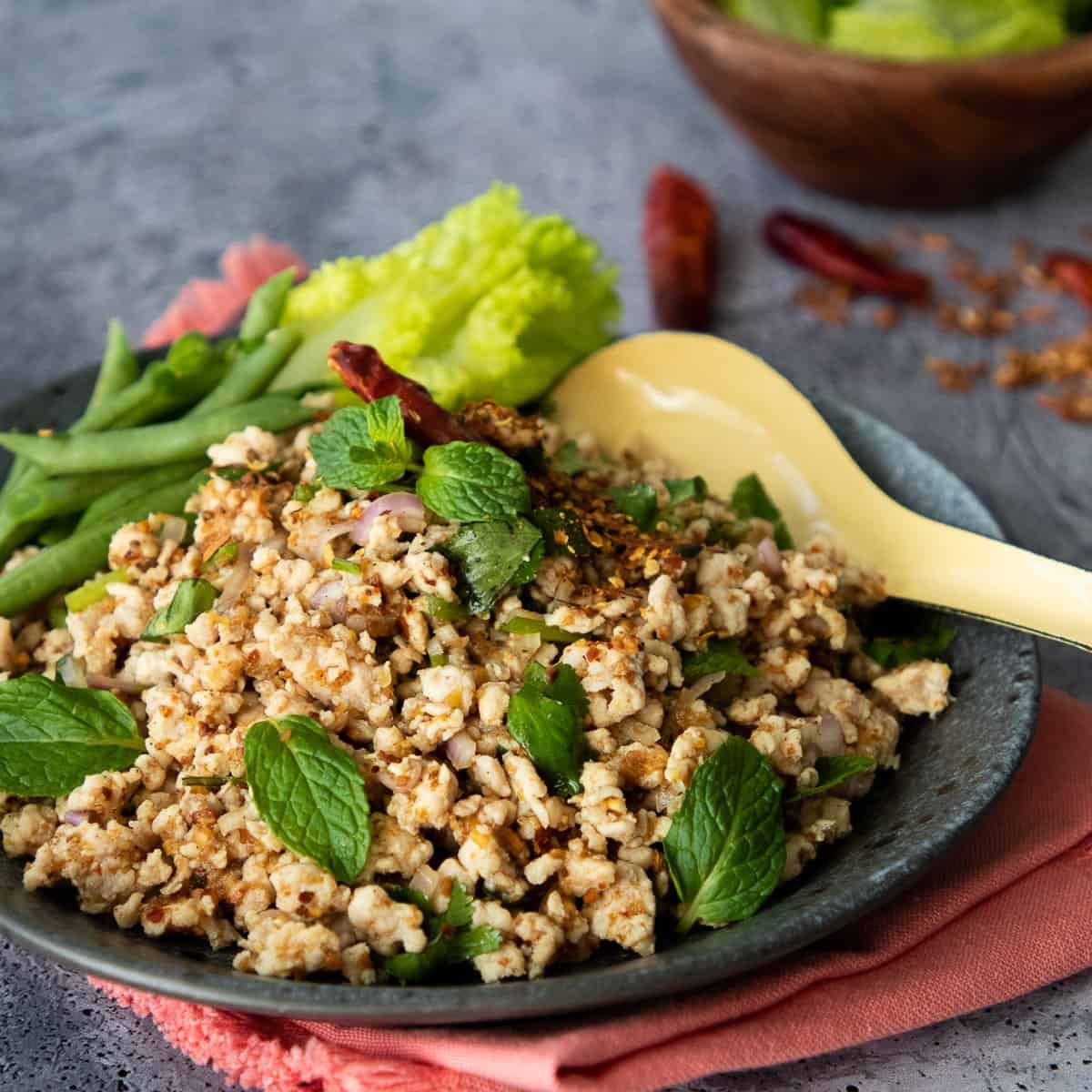
If you're craving something fresh, flavorful, and vibrant to pair with your favorite white wine (perhaps Farang's Sauvignon Blanc :-)), this Thai Laab Salad inspired by Kittinee, my wife, is exactly what your palate needs. Packed with bold Southeast Asian flavors, Laab (also spelled Larb) is a traditional Thai dish made from ground chicken, fresh herbs, lime juice, fish sauce, and toasted rice powder. It’s sour, savory, spicy, and totally customizable. This recipe is one of our favorite pairings with our Farang Sauvignon Blanc—the citrusy acidity and peach and acid notes of the wine enhance the lime and mint beautifully. Whether you're hosting a dinner party or craving something light and satisfying, this dish will impress. Why You’ll Love This Thai Laab Recipe Quick & easy: Ready in under 30 minutes Healthy & fresh: Packed with lean protein and herbs Customizable heat: Control the spice level to your liking Pairs perfectly with white wine: Especially Sauvignon Blanc Ingredients for Thai Chicken Laab You’ll find most of these simple ingredients at your local grocery store or Asian market: 2 Tbsp jasmine rice (to make the roasted rice, you can buy this but it is very easy to make) 2 Tbsp water 8 oz ground chicken ¼ cup fresh mint leaves 2 Tbsp chopped cilantro 2 Tbsp thinly sliced shallot 1 green onion, chopped 2 Tbsp fish sauce 2 Tbsp fresh lime juice 1–2 tsp chili flakes (adjust to your spice preference) How to Make Laab Salad 🔥 Step 1: Toast the Rice In a dry sauté pan over medium-low heat, toast the jasmine rice until golden brown and fragrant. Let it cool, then grind it in a spice grinder or small food processor until coarsely ground. This adds a nutty crunch and is key to authentic flavor. If you want to get really authentic, you can use a mortar and pestle, which tends to bring out deeper flavors in the rice. You are going for a grainy texture. 🍗 Step 2: Cook the Chicken In a medium pot, bring the water to a boil. Add the ground chicken, breaking it up as it cooks. Boil until it is fully cooked, about 5–7 minutes. Remove it from the heat. 🧅 Step 3: Mix in Flavor Immediately add the shallots so they wilt slightly in the residual heat. Stir in the roasted rice powder, fish sauce, lime juice, and chili flakes. Mix until well combined. 🌿 Step 4: Add Herbs & Serve Fold in the mint, cilantro, and green onion. Taste and adjust seasoning—more lime for brightness, more fish sauce for umami, more chili for heat. This is where your personal preferences really come into play. 🥬 Step 5: Serve Fresh Serve warm or at room temperature with crunchy raw vegetables like cabbage, cucumber, or lettuce leaves for scooping. Wine Pairing: Why Sauvignon Blanc Works So Well The zippy acidity and fruit profile of Sauvignon Blanc perfectly balance the heat and citrus of Laab. The crispness refreshes the palate, while the wine's subtle tropical fruit notes elevate the dish's complexity. Try this with our Farang Sauvignon Blanc— organically grown and crafted to complement vibrant Thai flavors.
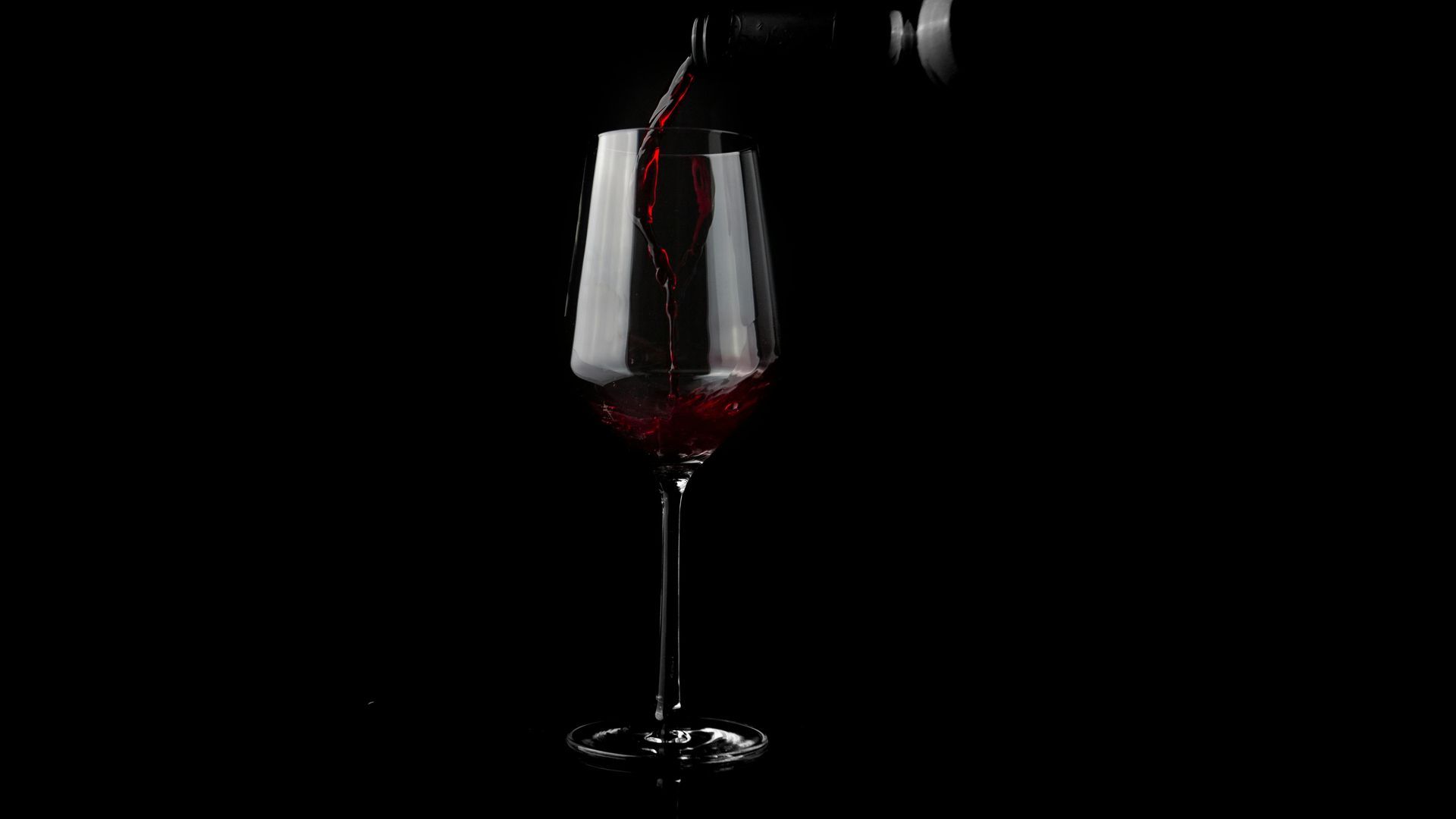
Cabernet Franc is often overshadowed by Cabernet Sauvignon and Merlot, but is that about to change? Interest in Cabernet Franc has been rising among winemakers, sommeliers, and consumers, not just as a blending tool, but as a primary variety. A Brief History of Cabernet Franc It is thought that Cabernet Franc probably originated in Southwest France and was well established in Bordeaux and the Basque region by the 17th century Cabernet Franc (also historically known as Bouchet) was already well established in the Loire Valley by the 17th century, and it was particularly championed at the Abbey of Bourgueil under the care of abbot Breton (hence its local synonym of Breton). This adaptability is one of the key features of the variety: it can ripen and grow world class wines in both warmer and cooler regions. The Loire Valley, Bordeaux, and Napa are key regions where Cabernet Franc thrives. Globally, it is now found in France, Italy, Hungary, Greece, Bulgaria, Slovenia, Croatia, Spain, Canada, Argentina, and the United States. It is also emerging in other parts of the globe such as Australia, New Zealand, South Africa and Chile. Cabernet Franc is considered a foundational variety and pre-dates Cabernet Sauvignon. In 1997 Dr Carole Meredith discovered through DNA analysis that Cabernet Franc, along with Sauvignon Blanc, is the parent of Cabernet Sauvignon. It is believed that this crossing happened in Bordeaux in the 17th century. Cabernet Franc is also a parent of Merlot and Carmenere, making it fundamental to the development of Bordeaux and Bordeaux-inspired wines as we know them. Since the 17th century Cabernet Franc has stood alongside Cabernet Sauvignon, Merlot, and Petite Verdot but more recently has started to stand more prominently on its own. This has been due to shifting consumer preferences, as well as ideal growing regions such as the Coombsville AVA in Napa Valley. In Bordeaux, Cabernet Franc has traditionally excelled as a blending variety, especially in partnership with Merlot on the right bank. In Napa Valley Cabernet Franc has also historically been thought of as blending variety, often used to bring aromatics and elegance to Cabernet Sauvignon. As Cabernet Franc is increasingly bottled under a varietal label in Napa Valley, it is still frequently partnered with Cabernet Sauvignon as a blending component. What Makes Cabernet Franc Unique? While the complex flavor profile varies by region, it is generally agreed that Cabernet Franc is a lighter body wine with herbaceous notes, red fruit flavors, and floral aromatics. Its medium to high acidity balances well with a relatively lower tannin structure that yields a smooth and velvety drinking experience. Compared to Cabernet Sauvignon, Cabernet Franc has a lighter, softer profile. This is a result of Cabernet Franc being more aromatic and less tannic. This gives Cabernet Franc the advantage of pairing with a wider range of foods. Its popularity has increased due to its versatility, ability to thrive in cooler climates, and potential to produce age-worthy elegant wines. As mentioned above, it can be paired with a wider range of foods than most other varietals. Climate change has caused growers to re-evaluate what they are growing, resulting in more Cabernet Franc being planted as it is more durable than Merlot. The quality of the wine has also improved with the experience winemakers are getting due to the rising demand. Cabernet Franc in Coombsville Napa Valley’s Coombsville AVA, produces Cabernet Franc with unique characteristics that set it apart from other regions. Coombsville’s proximity to the San Pablo Bay brings morning fog and cool breezes, extending the growing season. This results in slower ripening, allowing for greater flavor complexity and balanced acidity. Coombsville Cabernet Franc is known for bright red fruit (raspberry, cherry, cranberry) rather than the heavier black fruit found in warmer regions. It often showcases floral aromatics (violet, lavender) and herbal notes (sage, bay leaf), which are hallmarks of great Cabernet Franc. The longer hang time helps develop silky tannins and a refined, elegant mouthfeel. The region’s mix of volcanic ash and well-drained alluvial soils contributes to minerality and structure. This enhances the wine’s aging potential, allowing Coombsville Cabernet Franc to develop beautifully over time. Compared to warmer Napa regions, Coombsville’s cooler temperatures preserve higher natural acidity, making the wines fresh and vibrant. Lower alcohol levels (typically around 13.5%–14.5% ABV) create a more food-friendly and balanced wine. Many winemakers in Coombsville experiment with different techniques, including whole-cluster fermentation and extended maceration, to highlight the grape’s elegance. Some use neutral oak to preserve the purity of the fruit, while others age it in French oak for added depth. Coombsville Cabernet Franc stands out for its elegance, minerality, and complexity. It combines ripe yet fresh fruit, floral aromas, and refined tannins, making it a hidden gem in Napa Valley.
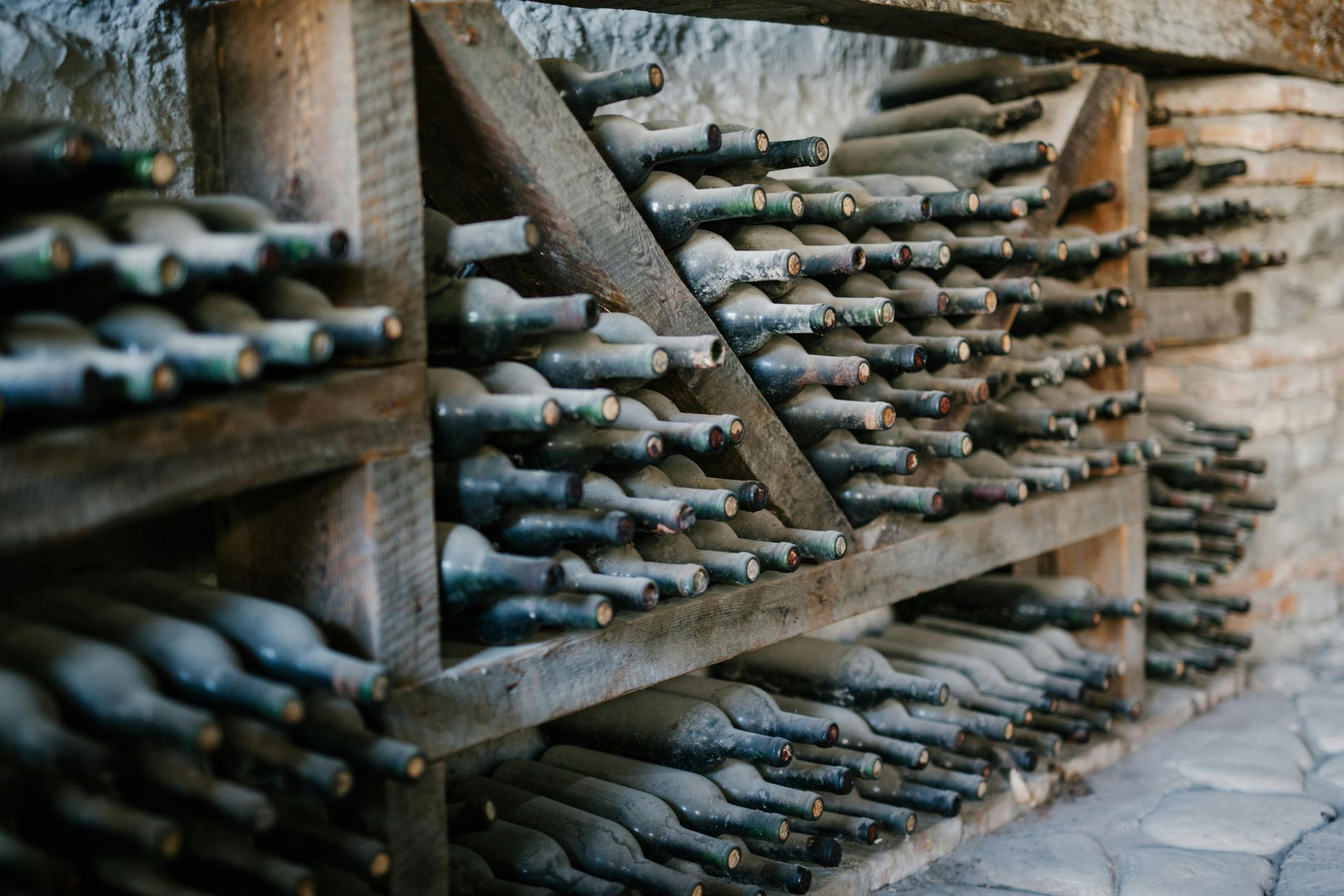
Can wine go bad? It’s a question many wine lovers ponder when they find a long-forgotten bottle in the back of their cupboard. Simply put, yes, wine can go bad. Naturally, understanding why this happens, how to spot the signs, and how to store wine properly can help you avoid pouring good wine down the drain. This will also help to answer the age-old question: how long should I cellar a wine? Does Wine Really Go Bad? Yes, wine can absolutely go bad. It’s important to distinguish between wine aging and wine spoiling. Wine’s ultimate journey is to become vinegar. Aging can enhance a wine’s flavor and complexity along this journey, but when wine spoils, it becomes undrinkable. Aging is about nurturing the wine in conditions that prevent microbial infestation over time. During this time, the cellular structure of some components within the wine breaks down or bonds. This results in a mellowing out of the wine and the development of aroma and flavors. If a wine is aged too long, it becomes completely flat and ultimately vinegar. Strangely enough, there are characteristics of spoilage that some wine lovers appreciate. Brettanomyces is an excellent example of this. As it is often casually referred to, Brett is a yeast that can spoil wines. Some winemakers (typically in Europe) use it to enhance the wine. While most wine drinkers say it smells like a stinky barnyard…to each their own! Spoilage is typically a wine infected by microbes, resulting in undrinkable wine. For beginners, it's a moment you recognize instantly by taste or smell. It becomes quite offensive. Spoilage can be caused by many things, such as growing practices, wine-making, bottling, and storage conditions. The bottom line is that both opened and unopened wine bottles are susceptible to spoilage under the wrong conditions. How to Tell If Wine Has Gone Bad Appearance Bubbles: Presence of bubbles when there shouldn’t be any Cloudiness or Sediment: While sediment is natural in aged wine, unexpected cloudiness can signal spoilage. Discoloration: Red wines may turn brick-brown, while white wines can darken to a deep yellow or brown. While the change in color is an indicator, it should not result in a conclusion. For example, I had a 40-year-old Vouvray that was almost brown and drank wonderfully. But if you see this in a wine that is less than three years old, something is wrong. Smell Vinegar-Like Odor: A strong smell of vinegar or nail polish remover indicates oxidation or bacterial contamination. Musty or Wet Cardboard Smell: This often means the wine is corked, a result of TCA contamination (rarer today than is was a decade ago). Taste Sour or Bitter Taste: Spoiled wine can taste overly acidic or bitter. Flat or Dull Flavors: If the wine has lost its complexity and tastes flat, it may have oxidized. Why Does Wine Go Bad? Oxidation: When wine is exposed to oxygen, its chemical structure changes. Over time, oxygen breaks down the wine's compounds, resulting in flat, lifeless flavors. Bacterial Contamination : Acetic acid bacteria can turn wine into vinegar. This typically happens when wine is exposed to oxygen for too long. Heat Damage: (AKA Wine Cooked) High temperatures can cause the wine to develop a cooked or stewed fruit flavor profile. Heat can also push the cork out slightly, allowing oxygen to seep in. This is often why wineries do not ship wine during the summer. Light Exposure: Light, especially UV rays, can degrade wine's delicate compounds, leading to a condition known as "lightstrike," where aromas and flavors are compromised. This is why premium wines are often placed in dark green bottles. Cork Failures and Storage Issues: Corks can dry out over time, allowing oxygen to infiltrate the bottle. Poor storage conditions, such as low humidity and high temperatures, also increase this risk. Microdoses of oxygen are often viewed as a key element to successfully aging wines. Generally speaking, exposure to oxygen during aging is the enemy of good wine. How Long Does Wine Last Before Going Bad? The two significant conditions of the wine to determine how long it will last before going bad is whether the bottle is opened or not opened. An open bottle of wine can last from 3 to 30 days whereas an unopened bottle can last from 1 to 40 years (in rare cases even longer). As you likely have become familiar with in your wine journey, a recurring theme in wine is that there is no clear answer here. It is good to have a base line for comparison so let’s start with that. Opened bottles will last as follows: Red, White & Rose: 3 days Sparkling will last 3 days but the bubbles often go flat a few hours after opening. Fortified wines such as port will last about a month Unopened bottles : This is a more delicate question to answer. As a general rule for the typical wine you may pick up at the grocery store, I would stick with 2 to 3 years unless it is fortified and it can be 20 years. At the far end of the spectrum there are other great wine producers where the wine can be stored 10+ years without spoiling. Premium Napa Valley red wines can go 5 to 10 years in the bottle, whereas epic wines such as Harlan Estates and Screaming Eagle can go beyond 20 years. French wines, both red and white, from Bordeaux and Burgundy can go 20+ years. When it comes to Rose’s, I generally recommend not aging them, as the spirit of them is to be fresh and acidic. The great part of the wine journey is that experience and personal preference serve as the best guides. It’s even better when you can share this journey with others because they can give you insights from their experience. The challenge is for you to decipher all of this to be in a place where you can rely on your own judge How to Keep Wine from Going Bad Light, oxygen and temperature have the most significant influence on whether or not your wine will be spoiled. Following are some precautionary measures you can take to avoid spoiling your wine: Store at the Right Temperature: Keep wine between 45-65°F (7-18°C). Fluctuations in temperature can be more harmful than temperature. Limit Light Exposure : Store bottles in a dark place or a wine fridge. UV rays can pierce the bottle and alter the wine. Maintain Humidity : Aim for 50-70% humidity to prevent cork drying. If corks dry out then too much oxygen will get into your wine and increase the risk that it will spoil. Use Wine Preservation Tools : Vacuum pumps and inert gas systems can help extend the life of opened bottles. Store Bottles Horizontally : This keeps the cork moist, preventing oxygen from invading. You will inevitably hear that microdoses of oxygen through the cork help to develop the wine but please understand that this is very small Age wine in large format bottles : The head space in a bottle of wine is the distance from the fill line to the bottom of the cork. In the head space is room for oxygen. The ration of oxygen to wine is significantly less in larger bottles than it is for standard 750ml bottles. If you want to age your wines longer, large format bottles help to reduce the risk of spoilage due to the lower ration of wine to oxygen exposure. Can You Still Drink Wine That’s Gone Bad? Drinking spoiled wine is usually safe but not enjoyable. Spoiled wine often tastes vinegary or flat. While it's not ideal for sipping, slightly spoiled wine can still be used for cooking, especially in stews or sauces. That said, I live by the rule, if you wouldn’t drink it then don’t cook with it. Conclusion Wine can go bad, but with proper storage and handling, you can extend its lifespan and enjoy every last drop. It is important to emphasize that there are many guidelines, but nothing can top your personal experience in defining your preferences. Whether it's learning to recognize the signs of spoilage or investing in the right preservation tools, taking care of your wine ensures that your next pour is as delightful as the first.
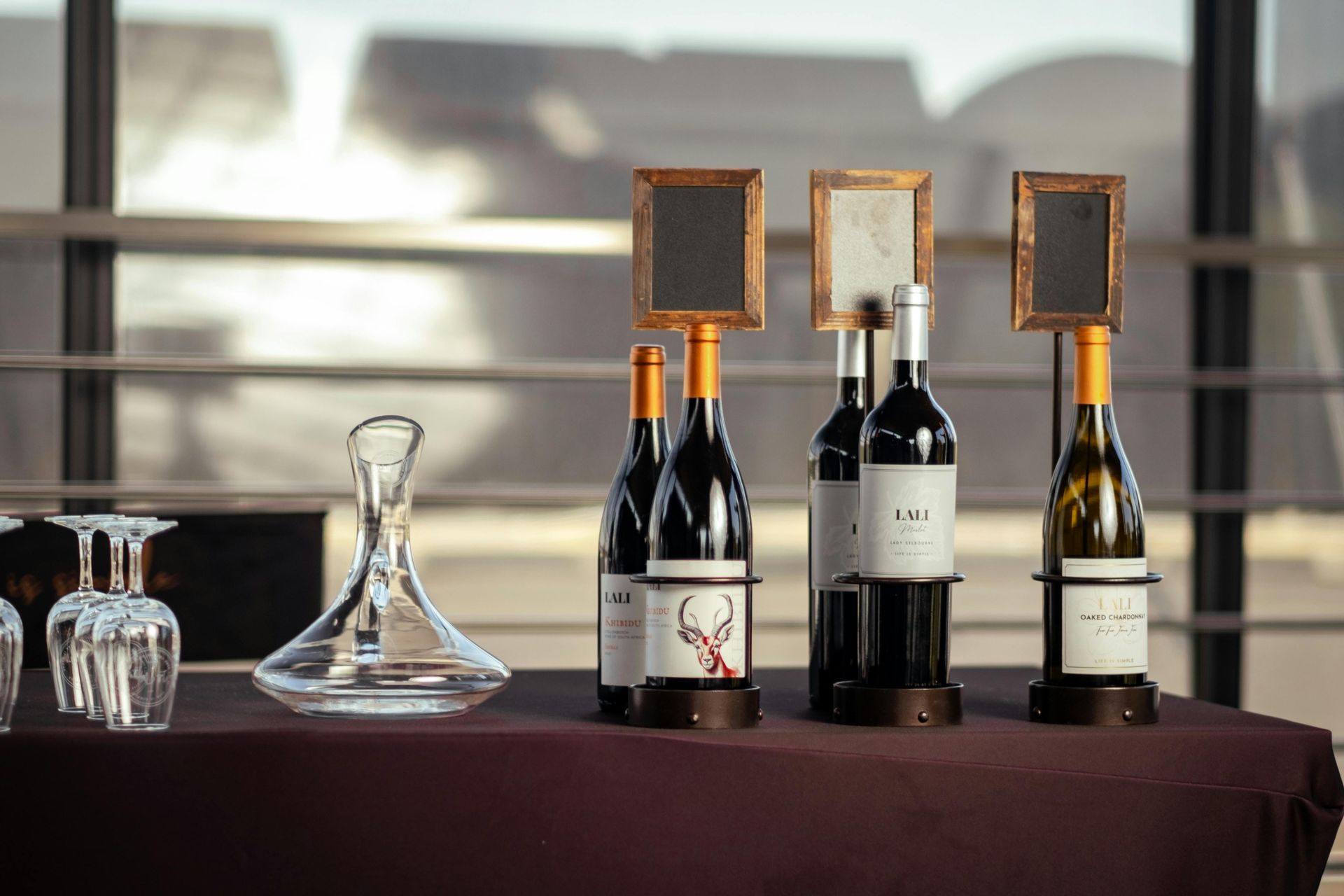
Decanting wine is an age-old practice that aims to improve the wine-drinking experience by improving aroma, flavor, and texture. Be it a cheap or expensive bottle, decanting can profoundly impact your wine experience for better or worse. Whether you’re enjoying a bold red or a delicate aged vintage, proper decanting can make all the difference in the world. But what does decanting wine mean? Why should you do it? And how long should you wait before taking that first sip? This guide covers everything you need to know about decanting wine for maximum enjoyment. What Is Wine Decanting? Decanting wine is the process of slowly pouring it from its bottle into another vessel, usually a glass decanter, to separate any sediment and allow oxygen to interact with the liquid. Oxygen’s interaction with wine causes reactions, such as oxidation, that change the wine’s aroma and taste. Decanting serves two primary purposes: Sediment Removal —Older red wines and vintage ports often develop sediment over time, resulting in a gritty texture if poured directly into a glass. The sediment is usually not a health concern but can detract from the overall experience. Aeration : Oxygen exposure softens tannins, enhances aromas, and brings out complex flavors, especially in young, full-bodied red wines. However, too much exposure can flatten a wine, so it is important to know how much and for how long you want your wine exposed to oxygen. We will discuss this later. Decanting vs. Aerating : While both processes expose wine to oxygen, decanting involves a slow, natural process, whereas aerators rapidly mix air into wine for instant results. If you can enjoy your wine over time, decanting allows you to experience how the wine evolves as it is exposed to oxygen. It also brings out subtleties in the wine that cannot be achieved with aeration. If time is not on your side and you need the wine to open up a bit then aeration is better than not doing anything. The wines that typically benefit the most from decanting are young, tannic, aged containing sediment, or full-bodied white wines. For young and tannic wines such as cabernet sauvignon, Syrah, and Malbec, decanting will soften the wine, creating a better balance among the tannin, alcohol, and aromatic components. Older red wines commonly develop harmless sediment as they age that can be removed by decanting. Full-bodied white wines such as Chardonnay can develop through decanting as well. Why Decant Wine? The Science Behind It Wine is a living, evolving beverage; decanting helps it “open up” by allowing oxygen to interact with its compounds. When wine is exposed to oxygen, the tannins combine with oxygen (chemical reaction) and become less astringent. Also, sulfur dioxide and other less pleasant compounds evaporate, leaving behind more pleasant aromatics and flavors. The sensory experience is altered by: Softening Harsh Tannins – Young, structured reds (like Cabernet Sauvignon and Syrah) can taste harsh straight from the bottle. Decanting helps mellow these tannins, making the wine smoother. Enhance Aromas and Flavors – Oxygen brings out hidden aromas in wine, allowing fruity, floral, and earthy notes to shine. Remove Unpleasant Smells – Some wines may have a “closed” or sulfur-like aroma upon opening, which can dissipate with decanting. Prevents Sediment in Your Glass – Aged wines, especially those 10+ years old, may develop sediment that can affect texture and taste. Misconceptions about Decanting Wine Common misconceptions are abundant when it comes to decanting wine. For example, some erroneously believe that only old wines should be decanted or that decanting is simply to let a wine breathe. Here is a rundown of the more common falsehoods: Falsehood 1 : Decanting is only for old red wines. While old red wines are eligible, as mentioned above, many other wines are also eligible. Falsehood 2 : All wines need to be decanted. Highly filtered, often cheaper wines not intended for aging do not often require decanting unless they have a heavy sulfur dioxide smell. Falsehood 3 : Decanting always makes a wine taste better. Some wines can go flat after too much exposure to oxygen. This is a risk with older wines and more delicate wines. With older wines, you may want to decant them to get the sediment out, but you need to keep an eye on them as they can go flat due to exposure to oxygen faster than a younger decanted wine. There are many other falsehoods, but if I can make one point, it is that you should know why you are decanting and the science behind it so that you can get the most out of your wine. How to Decant Wine: A Step-by-Step Guide Decanting wine is simple but requires care to achieve the best results. The best teacher is experience. The more you experiment with decanting, the better satisfied you will be when you do it. There is only so much instructions can teach, and, as is common with many aspects of wine, experience is the best teacher. To get started, follow these steps: Step 1: Choose the Right Decanter For young wines, use a wide-bottomed decanter to expose more surface area to air. For aged wines, use a narrower decanter to limit oxygen exposure. Step 2: Stand the Bottle Upright (for Aged Wines) If the wine has been stored horizontally, place it upright for a few hours to allow sediment to settle at the bottom. Step 3: Pour Slowly and Carefully Hold the bottle at a 45-degree angle and pour gently into the decanter to avoid disturbing sediment. Stop pouring if you see sediment reaching the bottle’s neck. Step 4: Using a Candle for Decanting (Optional…and fun) Place a candle or light source under the bottle’s neck to spot sediment while pouring. This classic technique is especially useful for older wines. Step 5: Let the Wine Breathe Allow time for oxygen to interact with the wine before serving. The next section covers how long you should wait. How Long Should You Decant Wine? General guidelines for decanting times are: Young, Full-Bodied Reds (Cabernet Sauvignon, Syrah, Malbec) – 1 to 2 hours. Medium-Bodied Reds (Merlot, Grenache, Sangiovese) – 30 minutes to 1 hour. Aged Reds (10+ years, Bordeaux, Barolo, Rioja, Burgundy) – 20 to 30 minutes (over-decanting can cause flavors to fade). Whites and Light Reds (Pinot Noir, Gamay, Chardonnay) – Typically not needed, but 15-30 minutes can enhance aroma. A good rule of thumb: Taste the wine periodically to determine when it’s ready. Experience will allow you to fine-tune these times to your preferences, different types of wine, and varying conditions (i.e., old, astringent, full-bodied, etc.). Conclusion Decanting wine is a simple yet powerful way to enhance its flavor, aroma, and texture. By understanding how and when to decant, you can elevate your wine experience and enjoy each bottle at its best. Whether you’re using a classic candle technique or opting for a modern aerator, the key is to experiment and find what works best for your favorite wines. Now it’s your turn! Try decanting a bottle tonight and taste the difference for yourself. Cheers!
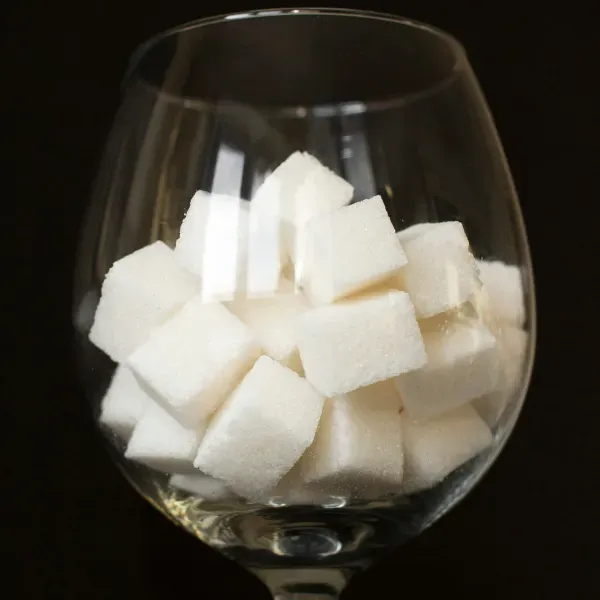
A friend recently converted to drinking white wine because they said it had less sugar. It bothered me because I thought that, in general, when wine is fermented, it effectively converts sugar into alcohol, leaving trace amounts of sugar…I decided to dig deeper. Let’s start with the understanding that the amount of sugar in your glass of wine (regardless of color) could rival some sodas or be nearly negligible. Sugar in wine is a topic that often surprises people, whether they’re calorie-conscious or simply curious about what goes into their favorite bottle. From decadent dessert wines to crisp, bone-dry varietals, the sugar content can vary dramatically. In this article, we’ll break down what sugar in wine means, the factors that influence it, and how you can choose the perfect wine based on sugar levels. What Is Sugar in Wine? Sugar in wine, often referred to as residual sugar (RS). This is the natural grape sugar left behind after fermentation. During the winemaking process, yeast consumes the sugar in grape juice to produce alcohol. There are two causes of RS: When the fermentation process is stopped early. This means that the yeast do not consume all the sugar so, some remains. This leads to a sweeter wine. Even if the fermentation is completed, the yeast does not digest some sugar types in grapes typically leaving 0.1g to 0.3g per liter of RS depending on the varietal. This is typically below the average person’s ability to taste. This is a dry wine. Significantly, most quality wines don’t have added sugar. The sweetness you taste should come directly from the grapes and the winemaking process, not artificial additives. There is a process known as Chaptalization, where winemakers add sugar to grapes before fermentation to increase the alcohol content (i.e. more sugar turns into more alcohol during fermentation) but the two points above remain valid. How we taste Sugar Content Vary in Wines? Did you know you can have a sweet-tasting wine with very low sugar content? The alcohol content and temperature can augment the perception of sweetness. The higher these variables are, the more your senses will perceive sweetness. So you can have a dry wine that tastes sweet if the alcohol level dominates the other aspects of the wine, such as tannins and other phenolic contributions. People generally start tasting sugar when there is 4 to 6 grams per liter. Less than 4 grams per liter sugar is usually not perceivable 4 to 12 grams per liter is where people start to perceive sweetness More than 12 grams per liter of sweetness is very perceivable, especially in low-acid wines Acidity can mask the taste of the sugar (sweetness), and that is typically why people incorrectly think white wines such as Sauvignon Blanc do not contain sugar. Why Does Sugar Content Vary in Wines? Sugar content will vary amongst wines primarily due to how ripe the grapes were when harvested, the winemaker’s fermentation strategy, the wine style, and the influence of the climate where the grapes are grown. Grape Ripeness The sugar level in the grapes at harvest can directly affect the wine’s residual sugar. Riper grapes, often grown in warmer climates, naturally contain more sugar than those grown in cooler regions. This has the opposite effect on the acidity content of the grape (i.e., the warmer climates reduce acidity as sugar levels increase). What makes some wine regions better (partly) than others is that the growing season is warm and long enough to produce grapes with the perfect balance of sugar and acidity. Fermentation Process Winemakers have control over how much sugar remains in the wine. For instance, stopping fermentation early leaves more residual sugar, while allowing it to complete results in a drier wine. Fermentations are stopped early intentionally or not intentionally. Winemakers will generally do this intentionally to make sweeter or fortified wines. For large winemakers, when fermentation unintentionally does not finish, they sometimes blend the sweet wine with other wines that do fully ferment. Wine Style Certain wine styles are naturally sweeter due to winemaking traditions or consumer demand. Sweet wines, such as dessert wines, are intentionally crafted to retain higher levels of sugar. German Rieslings are grown in cold environments where the wine is typically too acidic for consumers so they will halt fermentation to have a level of sugar in balance with the acidity that is more appetizing for their consumers. Climate Influence Warm-climate regions, like California or Australia, tend to produce riper grapes with higher sugar content compared to cool-climate areas like Germany or New Zealand. This difference often translates into wines with varying sweetness levels. The cooler the climate, the more acidic it is, whereas the warmer the climate, the more sugar is produced in the grapes. The premium wines typically are places where the growing season is warm and long enough to bring the sugar and acid into balance…Burgundy, Napa, etc. Which Wines Have the Most Sugar? Some wines are intentionally designed to be sweet, making them a dessert-like treat. Following are a few types of wines that typically have the highest sugar content: Dessert Wines: Port, Sauternes, and Ice Wine can contain 100 to 200 grams of sugar per liter Sweet Sparkling Wines: Moscato d’Asti and Prosecco labeled “Extra Dry” (ironically, it’s sweeter than “Brut”) often range from 17 to 50 grams of sugar per liter Off-Dry White Wines: Some Rieslings and Gewürztraminers can have a noticeable sweetness, typically around 10 to 30 grams of sugar per liter. A can of soda has about 39 grams of sugar, which means some sweet wines can exceed that amount in just a glass! Which Wines Have the Least Sugar? If you are looking to minimize sugar intake, there are many wines that offer a dry and low-sugar option: Dry Reds: Wines like Pinot Noir, Cabernet Sauvignon, and Merlot typically contain less than 1 gram of sugar per glass. Dry Whites: Sauvignon Blanc, Chardonnay, and Albariño are excellent choices with minimal residual sugar. Brut Sparkling Wines: Brut Champagne and sparkling wines often have less than 12 grams of sugar per liter, with “Brut Nature” containing less than 3 grams How Sugar in Wine Affects Your Health and Lifestyle Calories Sugar directly impacts the calorie content of wine. A sweeter wine will naturally have more calories than a dry one. For example, a 5-ounce glass of dry wine might contain about 120 calories, while a sweet wine could have 160 or more. Dietary Concerns Low-carb and keto diets often focus on minimizing sugar intake. Dry wines, with less than 1 gram of sugar per glass, are usually safe options. For individuals with diabetes, monitoring sugar in wine is particularly important, though moderate consumption of dry wine is often permissible. Hangovers While sugar itself doesn’t cause hangovers, the combination of sugar and alcohol can exacerbate dehydration, potentially making hangovers worse. Opting for dry wines might help reduce this risk. How to Choose the Right Wine Based on Sugar Levels Read the Labels Look for terms like “Dry,” “Off-Dry,” or “Sweet” on the label. “Brut” on sparkling wines indicates a drier style, while “Demi-Sec” or “Doux” signals sweetness. Ask the Experts When in doubt, ask your sommelier or wine shop staff for recommendations. They can guide you toward wines with low sugar content. Use Wine Apps Apps like Vivino or Wine-Searcher often include details about a wine’s sweetness level and style, making it easier to choose the right bottle. Conclusion and Takeaways Sugar levels in wine can vary widely, from bone-dry reds with negligible sugar to decadent dessert wines packed with sweetness. Understanding residual sugar and how it shapes the wine you drink allows you to make more informed choices. Whether you prefer a crisp, dry Sauvignon Blanc or a rich, sweet Port, there’s a wine for every palate and lifestyle. Next time you’re choosing a bottle, consider the sugar content—your taste buds and health will thank you!
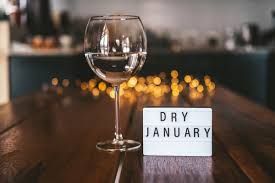
Dry January has been increasing in popularity, encouraging people to begin the year by abstaining from alcohol for the entire month. This movement offers an opportunity to reset after the indulgences of the holiday season and experience the benefits of living alcohol-free. In this article, we'll explore the benefits of Dr y January, alternative drink options, and tips for successfully completing the challenge. The purpose of this article is to provide a comprehensive guide to help readers successfully complete Dry January. What is Dry January and Why You Should Try It? Dry January is a month-long challenge where participants commit to avoiding alcoholic beverages throughout January. The movement started in 2011 when Emily Robinson decided to abstain from alcohol to prepare for a marathon. She later joined Alcohol Concern , a UK-based charity addressing the harms of alcohol abuse, which officially launched Dry January in 2013 with 4,000 participants. Since then, participation has soared to over 175,000 known participants, with many more joining unofficially. Taking a month-long break from alcohol is a New Year resolution many of us make. There are several benefits to the decision to abstain for a month, such as improved physical health, enhanced mental clarity and mood, financial savings, and increased self-awareness about your drinking habits. According to a report by the National Library of Medicine, participating in Dry January can offer various health benefits, even if it doesn't lead to long-term changes in drinking habits: Improved Physical Health : Participants can experience weight loss, improved liver function, and reduced blood pressure. Better Sleep : Alcohol can disrupt sleep cycles, so abstaining can lead to more restorative and deeper sleep. Boosted Energy Levels : Many report feeling more energized and alert throughout the day. Mental Clarity : Participants often experience reduced brain fog and improved focus. Financial Savings : Skipping alcohol can lead to noticeable savings, similar to making coffee at home instead of buying it from a store. Stronger Self-Control : Successfully completing Dry January can enhance confidence in one’s ability to set and achieve goals. So now that you resolved, let's dig deeper into how you can set yourself up for success! Preparing for Dry January Successfully completing Dry January requires planning and motivation. What is the best way to set yourself up for success this Dry January? Everyone is different when it comes to motivation. One of the best things that works for me is to make a friend group effort. Being accountable for the success of your friends is a great motivator, and it helps that they are not pressuring you to drink because you are all in it together. Like any good idea, setting out a plan for how you will be successful in its execution requires preparation. Let's focus on three steps for successful preparation: setting clear goals, removing temptations, and planning for social situations. Set Clear Goals To successfully set clear goals, start by asking yourself why you are doing this in the first place. We all have different reasons, such as health benefits, strengthening our self-discipline, curiosity, and supporting other friends. No reason is off-limits. The idea here is to be honest with yourself. Once you have an honest and clear idea of why you are participating in Dry January, write these goals down so that you can reflect on them as motivation for successfully accomplishing your goals. Remove Temptations As part of the human condition, it is safe to say that sometimes our will is strong and sometimes weak. Think about your weak moments. For example, you may be in the habit of winding down with a beer from the fridge after a long day's work or cracking a bottle of wine whenever you make Italian meals for the family. Identifying these triggers and having alternatives that satisfy you at the ready is crucial. Some alternatives include mocktails, sparkling water, non-alcoholic beer, kombucha, and smoothies. Plan for Social Situations Many of us can expect to be in social situations that are centered around alcoholic drinks being served. Peer pressure did not end in high school. It just became more subtle and sophisticated. You need to prepare yourself to answer the question when people ask you why you are not drinking. One trick I use to avoid questions about why I am not drinking alcohol as an adult is to order sparkling water with lime when I am out. The drink's appearance fits the scene, so you avoid asking the question. Another behavior you can change is meeting people for coffee rather than a drink. Overcoming Challenges: Tips for a Successful Dry January The reality is that so many recognize Dry January that when you say you are participating in it there is no negative s ocial stigma. Here are some tips to help you stay on track: Set Clear Goals : As we said above, write down why you’re participating and revisit these reasons when tempted. Stay true to yourself. Plan Ahead : Stock up on alcohol-free alternatives for social events. You have to accept that you will be around and tempted by alcohol. Identify your triggers and make sure you make alternatives to alcohol available to you in those moments. Find a Support System : Encourage friends or family to join you or connect with online communities. Track Your Progress : Use an app or journal to log experiences and celebrate milestones. Practice Saying “No” : Prepare responses for when you’re offered a drink. Have a couple of reasons at the ready so that you can be light-hearted, thoughtful, reverent, or whatever the social situation may require in order for you to be graceful in the moment. Reward Yourself : Use the money saved to treat yourself to a new book, spa day, or fun outing. Focus on the Positives : Be mindful of the physical and mental benefits you’re experiencing. Dry January Drinks Skipping alcohol doesn't mean missing out on delicious beverages. Here are some alcohol-free drink ideas to keep your taste buds entertained: Mocktails : Create non-alcoholic versions of your favorite cocktails, like a virgin mojito or a fruity spritzer. Herbal Teas : Enjoy calming, warm herbal teas like dandelion tea, which offers numerous health benefits. Sparkling Water : Add a slice of lemon or lime for a refreshing twist. Non-Alcoholic Beers and Wines : Explore alternatives that mimic the taste of alcoholic counterparts. Kombucha : This fermented tea offers a fizzy, tangy option with probiotic benefits. Smoothies : Blend your favorite fruits and veggies for a nutritious, alcohol-free treat. Conclusion Dry January is more than a trend—it's a global event. It provides an opportunity to participate with others in prioritizing health, resetting habits, and starting the year focusing on long-term goals. Whether aiming to improve physical health, save money, or challenge yourself, this month-long commitment can bring lasting benefits. With delicious alcohol-free drink options and the right mindset, you'll be well-equipped to make it through a successful Dry January.
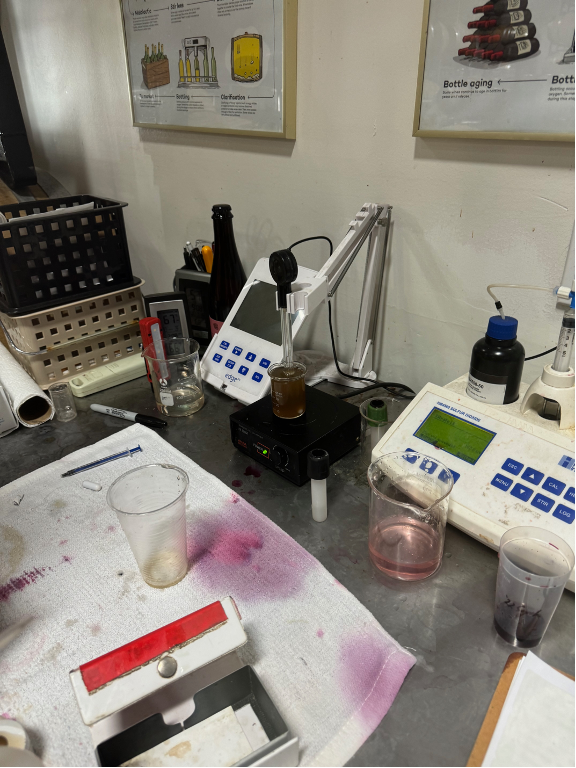
Has a friend told you they can’t drink wine because the sulfites give them a headache? I have been to wineries that market themselves as headache-free wines because they do not use sulfites. Accredited and peer-reviewed research has not been able to support this myth. What are sulfites in wine? “Sulfites” is a term in the wine industry that refers to sulfur dioxide (SO2). They are used during winemaking and bottling to keep unwanted microbial activity from spoiling the wine. How are sulfites used in winemaking? After the grapes are harvested, the must or juice is fermented using yeast to convert sugars to alcohol. The type of yeast used plays a role in developing the wine's taste profile. There are many yeast options to keep things simple; fermentation can be controlled or natural. A controlled fermentation is where a specific yeast strain is chosen with the intention of the impact it will have on the wine. To ensure that a chosen strain dominates fermentation, SO2 (sulfites) is added to remove competing microbes that could otherwise inhibit the fermentations or spoil the wine. Natural fermentation is when the winemaker uses the yeast on the grapes or floating around in the winery. Natural fermentation is risky because the winemaker is gambling on the odds of a yeast strain that may or may not have a good impact on their wine. There are a lot of microbes in the pre-fermented juice that can have an off-putting effect on the wine. Given the high cost of wine production, it is often not worth the gamble for winemakers to use a natural fermentation process. Sulfites are in all wines, regardless of what the wine label says. Sulfites naturally occur regardless of the fermentation method used. The US requires wine labels to disclose only if sulfites are added during winemaking (Andrew Waterhouse, UC Davis). This means that regardless of which country the wine is from or what the label says, your wine likely has sulfites. No medical research data can support the assertion that sulfites cause headaches. Research has linked what causes wine headaches to those who drink red wine (Bakalinsky), but what causes red wine headaches has only been hypothesized up until today. The following are what research has shown to cause headaches for wine drinkers: • Quercetin: Found in red wine and in high quantities, it can lead to a build-up of acetaldehyde, a known cause of headaches. The amount of wine you need to drink to get to problematic levels will likely make you hungover (a completely different topic). • Alcohol: This will cause you to dehydrate • Sugar: Sweet wines with residual sugar can accelerate dehydration. • Less common: People with Tyramine and Histamine intolerances Voodoo Science: My personal experience has been that lower quality (often cheaper) wines have a higher correlation to headaches than premium wines. Wineries do not have to disclose most of what they put into the wine. Cheaper wines are typically produced in large volumes that require additives to create a consistent taste, longer shelf-life, and avoid spoilage. Premium wines are given a lot of attention in a way that avoids the need for additives, and the market has a deeper appreciation for the variability of the wine, such that it expresses the nuances of the growing season. The downside is that given the labor and materials it takes to produce a premium wine; they are often expensive. No more wine headaches! My recommendation is to drink what you love responsibly. Moderation and drinking water play a more important role in avoiding headaches than anything else. A.T. Bakalinsky, Sulfites, Wine and Health, in Wine in Context: Nutrition, Physiology, Policy, A.L. Waterhouse and R.M. Rantz, Eds. American Society for Enology and Viticulture, Davis, 1996
